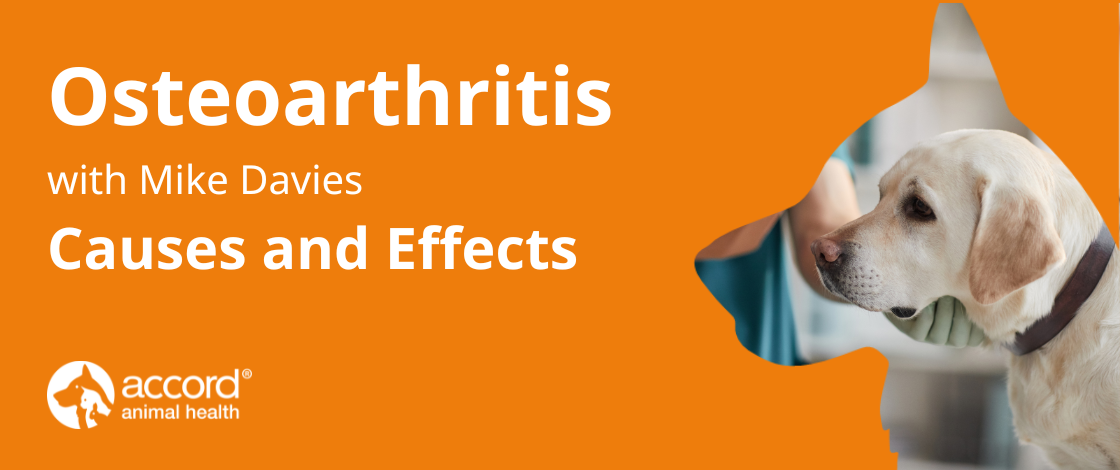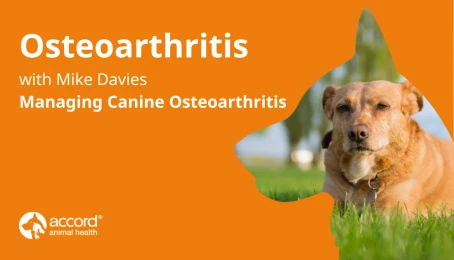In the first part of our three-part series, Mike Davies an RCVS specialist in veterinary nutrition, writes in detail about Osteoarthritis with part one being on causes and effects.
Osteoarthritis - Overview
Osteoarthritis (OA) is a degenerative joint disease that results in abnormal remodelling of the affected joint (bone, cartilage and soft tissues) as a result of numerous inflammatory mediators within the affected joint.
The disease starts with inflammation, often following injury or excessive or abnormal wear and tear. New bone deposits (osteophytes) are formed around the margins of the joint where the joint capsule and ligaments impinge on the bone. OA is usually chronically progressive and other pathologic changes include degradation of the articular cartilage, thickening of the subchondral bone, synovial inflammation, degeneration of ligaments and, in the stifle, the menisci, and hypertrophy of the joint capsule (Loeser and others 2012).

Eventually OA results in severe articular cartilage erosion and exposure of underlying bone. Clinical signs include pain, stiffness, joint swelling, lameness, crepitus, restricted range of joint movement, abnormal posture and, in advanced cases, joint ankylosis.
In OA the chondrocytes become “activated” and characterised by cell proliferation and increased production of both matrix proteins and matrix-degrading enzymes (Goldring and others 2009). The latter include aggrecanases and collagenases, which are members of the matrix metalloproteinase (MMP) family, as well as several serine and cysteine proteinases (Troeberg and others 2022).
Matrix degradation in early OA may be due to MMP-3 and A Disintegrin and Metalloproteinase with Thrombospondin Motifs 5 (ADAMTS-5), which degrade aggrecan, followed by increased activity of collagenases, in particular MMP-13, which is highly efficient at degrading type II collagen. Once the collagen network is degraded, it is irreversible.
Chondrocytes in OA cartilage express cytokine and chemokine receptors, MMPs, and a number of genes that enhance or modulate inflammatory and catabolic responses, including the enzyme cyclooxygenase (COX)-2, microsomal PGE synthase-1 (mPGES-1), soluble phospholipase A2 (sPLA2), and inducible nitric oxide synthase (NOS2).
Matrix degradation is driven by MMP-1,-3,-9,-13, ADAMTs-4, -5, cathepsin K, serine proteases (Htra1) driven by cytokines (IL- 1,-6,-7,-8,-17,-18, OSM), chemokines (IL-8,GRO-α,-γ, RANTES, MCP-1) and others (S100 proteins, TGFα, matrix fragments, leukotrienes and prostaglandins) inhibitors, TIMPs, anti- cytokine therapy, TLR inhibition, MAP kinase inhibition, NFκB inhibition, lipoxygenease and cyclooxygenase. (Loeser and others 2022)
Epigenetic mechanisms also play a role through modulation of the DNA methylation status on promoters driving expression of, for example, IL1β and MMP13 genes or through dysregulation of the microRNAs that are important for maintenance of homeostasis.
Synovial inflammation and secreted damage-associated molecular patterns (DAMPs) or alarmins, that act as ligands of Toll-like receptors (TLR) or Receptor for Advanced Glycation Endproducts (RAGE), in the activation of inflammatory and catabolic events in articular cartilage.
As articular cartilage matrix proteins are degraded, fragments including fibronectin, small leucine-rich proteoglycans, and collagen are formed. Fibronectin and collagen fragments stimulate the production of inflammatory cytokines, chemokines, and MMPs. Inflammation also may be driven by degradation products through activation of innate immune responses.
Osteoarthritis (OA) is a common disease in both dogs and cats but can be difficult for owners to recognise, particularly in the early stages. It is now estimated that up to 38% of dogs may have the disease from as early as 1 year of age (Wright and others 2022).

Underlying causes of canine osteoarthritis have been summarised in a Systematic Review (Anderson and others 2020) and include joint malignment due to congenital skeletal disorders (for example patellar luxation, hip dysplasia) and common developmental skeletal disease (angular limb deformities, osteochondrosis dissecans, medial coronoid process fragmentation, ununited anconeal process) which are mainly caused by nutritional errors.
Excessive body weight exacerbates the adverse effects of OA and weight loss in overweight patients can improve pain and lameness (Marshall and others 2009). As well as reduced biomechanical forces, this may be linked to adipokines which are hormones and mediators secreted by adipocytes in body fat. Leptin and adiponectin are adipokines present in synovial fluid, and leptin is upregulated in osteoarthritic joint tissues. In vitro, these have detrimental effects on chondrocytes by other proinflammatory cytokines, such as matrix metalloproteinases -6, -9 and -13. (Walton 2016)
High body mass exacerbates lameness in dogs with OA as measured using force plate analysis (Moreau et al, 2010)
The Omega-3 fatty acids EPA/DHA have immunomodulatory and anti-inflammatory effects by inhibiting the arachidonic acid cascade, which produces proinflammatory metabolites such as leukotrienes, prostaglandins, and thromboxanes (Shahidi and Ambigaipalan 2018; James and others 2003).



